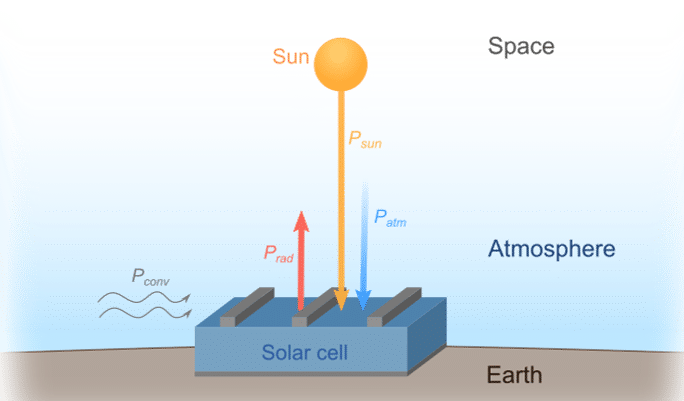From pv magazine Global.
Scientists have studied radiative sky cooling (RSC) at the research level as a potential passive cooling technique for buildings and solar modules. RSC occurs when the surface of an object absorbs less radiation from its environment and less than the energy it radiates. When this happens, the surface loses heat to the outer space and a cooling effect can be achieved without the need for power.
Researchers from France’s Institut des Nanotechnologies de Lyon (INL) recently started studying the effects of RSC on single-junction solar cells. They aim to determine the ideal thermal emissivity profile of cells that could allow the best cooling. “We also quantified the cooling potential in a broad range of scenarios,” researcher Jérémy Dumoulin told pv magazine.
The scientists explained that PV systems are naturally good candidates for RSC techniques, which use the transparency of the earth’s atmosphere in the 8-micrometer to 13-micrometer range, in order to enhance radiative heat transfer.
“In practice, improving RSC consists in tuning the optical absorption and thermal emission in the infrared range which makes it possible to also reduce the absorption of sub-bandgap photons, referred hereafter as parasitic solar absorption,” they said.
Dumoulin said the technique could be applied in module manufacturing by changing the optical properties of the glass cover. RSC could also be improved to some extent by changing the optical properties of the cells. “We are currently exploring different technical pathways to obtain the desired emissivity while maintaining low cost,” he said.
The academics initially developed a thermal and electrical model to measure cell temperature and yield. They then created a “step model” to establish the cell’s emissivity profile. They used this modeling framework to compare the selective and broadband emissivity profiles in different scenarios.
The scientists claim the broadband profile is the ideal choice, as it ensures lower temperatures and higher electrical power output under most environmental conditions, as long as the bandgap is around 2.3 eV. The selective profile is only the most appropriate option in solar cells with a bandgap energy of more than 2.3 eV. Crystalline silicon (C-Si), for example, has a bandgap energy of 1.11 eV and cadmium telluride (CdTe), which is less efficient than C-Si for power generation, has a bandgap of 1.44 eV.
The broadband profile achieved lower module temperatures and a higher power yield for a crystalline silicon cell with a 1.12 eV bandgap, provided that solar illumination surpasses 300 W/mw, and for a perovskite cell with a 1.64 eV, as long as solar illumination exceeds 500 W/m2. “This is valid even if convection is suppressed and under clear sky conditions,” Dumoulin said.
In their simulation, the researchers determined that RSC improvements might lead to a reduction in PV module temperatures of around 10 C. This in turn could raise the performance of the devices by more than 5 W/m2.
“For Si-based devices with high non-radiative recombination, our model predicts an even higher temperature reduction,” the research group said. “Even in the worst scenario – a thick device with initially good thermal management on the front and the rear – a broadband profile can further reduce the temperature by almost 3 C.”
Thus far, they have only simulated their proposed technique, so they can first identify the thermal emissivity profile they need to achieve and its potential benefit. They hope this will justify further research. “We plan to make tests on both cells and modules,” Dumoulin said.
They described the passive cooling technique in “Radiative sky cooling of solar cells: fundamental modeling and cooling potential of single-junction devices,” which was recently published in Sustainable Energy and Fuels.
This content is protected by copyright and may not be reused. If you want to cooperate with us and would like to reuse some of our content, please contact: editors@pv-magazine.com.









By submitting this form you agree to pv magazine using your data for the purposes of publishing your comment.
Your personal data will only be disclosed or otherwise transmitted to third parties for the purposes of spam filtering or if this is necessary for technical maintenance of the website. Any other transfer to third parties will not take place unless this is justified on the basis of applicable data protection regulations or if pv magazine is legally obliged to do so.
You may revoke this consent at any time with effect for the future, in which case your personal data will be deleted immediately. Otherwise, your data will be deleted if pv magazine has processed your request or the purpose of data storage is fulfilled.
Further information on data privacy can be found in our Data Protection Policy.